If you’re like most people, your kitchen sink is one of the busiest areas in your home. It’s also one of the most important areas where you prepare food and clean dishes. Because of this, it’s important to take steps to protect the wall behind your kitchen sink from water damage. In this guide, we’re going to discuss how to protect wall behind kitchen sink.
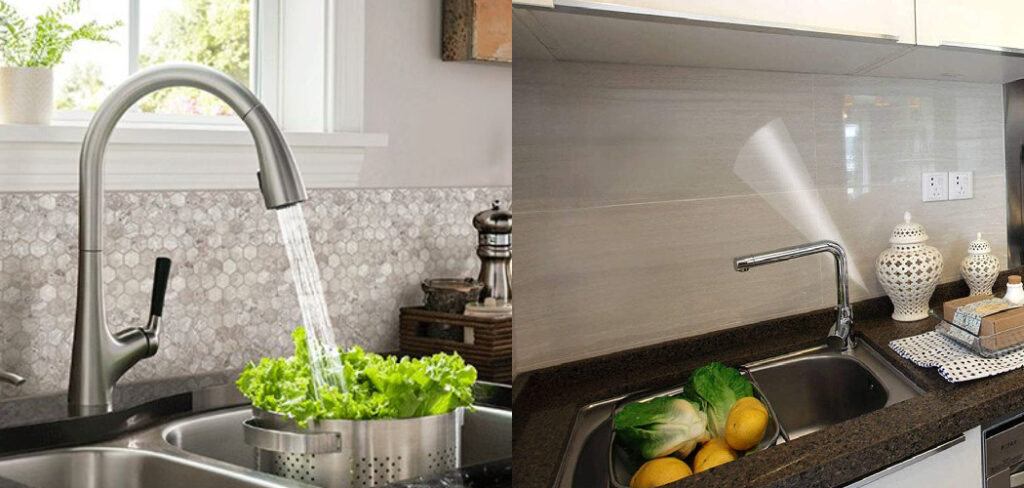
This can be done by installing a backsplash or using a waterproof sealant. In addition, be sure to regularly check for leaks and fix them as soon as possible. By following these tips, you can help keep your kitchen looking beautiful and protect your walls from water damage. We will also provide tips on how to prevent water damage in the future. Read on for more information.
11 Reasons That Causes Leaks Behind Kitchen Sink:
1. Worn Out or Damaged Sealant:
Over time, the sealant around your sink can degrade, allowing water to seep through. As the sealant wears away, it will no longer be able to create a watertight barrier, exposing your wall to potential water damage. Be sure to regularly check the sealant around your sink and replace it if it shows signs of wear and tear.
You can easily remove old sealant by using a utility knife or scraper, and then apply a fresh coat of waterproof sealant. This simple step can go a long way in preventing water damage to your walls.
2. Cracks in the Tile:
If you have a tile backsplash, it’s important to check it regularly for cracks. Cracks in the Tile can allow water to seep through and cause damage to your wall. If you notice any cracks, repair them as soon as possible. Also, check the grout around the Tile to ensure it’s in good condition.
But using a tile sealer, you can add an extra layer of protection against water damage and keep your kitchen looking great.
3. Poorly Installed Backsplash:
If you have a backsplash, be sure that it’s installed correctly. If the backsplash is not installed properly, it can leave gaps that allow water to seep through. Ensure that the backsplash is sealed properly and that there are no gaps. The backsplash can also be installed too low, leaving a gap between the countertop and the backsplash. If this is the case, be sure to caulk this area to prevent water from seeping.
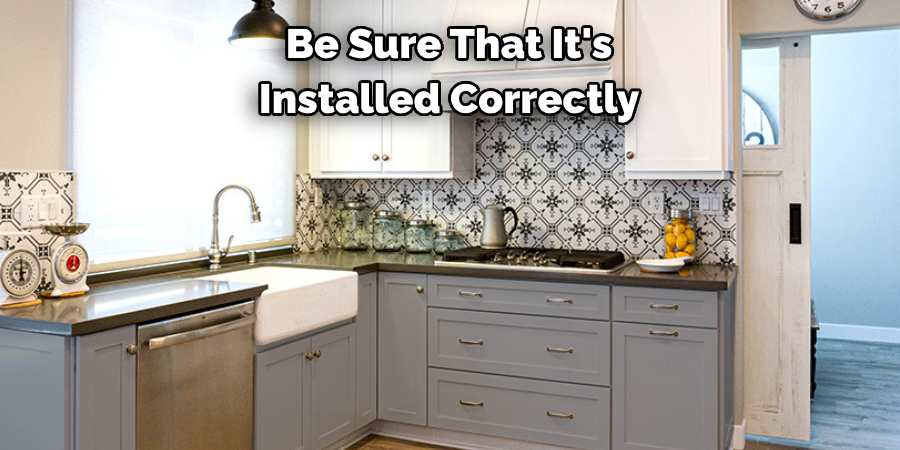
It’s always a good idea to have your backsplash installed by a professional to ensure it’s done correctly and provides adequate protection for your walls.
4. Clogged Drainage System:
If your drainage system is clogged, it can cause water to back up and seep through the cracks in your sink. Be sure to clean your drains regularly to prevent this from happening. In addition, if you notice that water is starting to pool around your sink, it’s a good idea to call a plumber to unclog the drain.
The best way to prevent clogged drains is to be mindful of what you put down the sink. Avoid pouring grease, coffee grounds, and other debris down the drain, as these can easily cause clogging.
5. Worn-Out Gaskets:
The gaskets around your sink can become worn out over time, which can cause water to seep through. Be sure to check the condition of your gaskets regularly and replace them if necessary. If the gaskets are not sealing properly, water can leak through and cause damage to your walls. Also, make sure that the screws that hold the gaskets in place are snug and not loose.
You can easily find replacement gaskets at your local home improvement store and replace them yourself, or you can call a professional to handle the task for you.
6. Cracks in the Countertop:
If you have a countertop, it’s important to check it regularly for cracks. Cracks in the countertop can allow water to seep through and cause damage to your walls. If you notice any cracks, repair them as soon as possible. Also, check the sealant around the edges of the countertop to ensure it’s in good condition.
It’s also a good idea to seal your countertop regularly to prevent water from seeping through and causing damage. You can use a granite sealer for natural stone countertops or a food-safe sealant for other types of countertops.
7. Improperly Installed Cabinets:
If you have cabinets, be sure that they’re installed correctly. If the cabinets are not installed properly, they can leave gaps that allow water to seep through. Ensure that the cabinets are sealed properly and that there are no gaps. The cabinets can also be installed too close to the sink, which can cause problems.
It’s important to have your cabinets installed by a professional to ensure they are properly sealed and provide adequate protection for your walls.
8. Leaky Pipes:
If your kitchen sink is leaking, it is important to take care of the problem immediately. Leaky pipes can cause serious damage to your home, and they can be expensive to repair. One way to protect your wall behind the kitchen sink is to use a rubber mat. Rubber mats are available at most hardware stores and can be cut to fit any size sink. When placing the mat under the sink, make sure that the mat is larger than the leak. This will help to prevent any further damage to your wall.
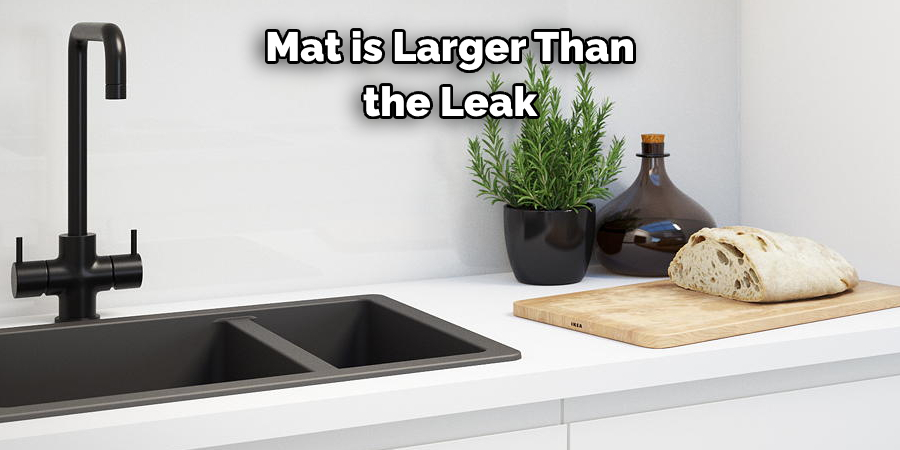
It’s also important to regularly check for leaks and fix them as soon as possible. This will not only protect your walls but also save you from costly repairs in the future.
9. Incorrect Use of Caulk:
Caulk is commonly used to seal gaps and prevent water from seeping through. However, if it’s not applied properly, it can actually cause more harm than good. Be sure to follow the manufacturer’s instructions when using caulk and ensure that it properly seals any gaps around your sink.
It’s also a good idea to replace old or cracked caulk regularly to maintain its effectiveness in preventing water damage.
10. Poor Ventilation:
A lack of proper ventilation in your kitchen can lead to excess humidity and moisture, which can cause water to seep through your walls. Be sure to use an exhaust fan or open a window when cooking or running the dishwasher to allow moisture to escape. It’s also important to regularly clean your exhaust fan to ensure it is functioning properly.
Proper ventilation not only helps prevent water damage but it can also improve air quality in your kitchen, making it a healthier environment for you and your family.
Following these tips on how to protect wall behind kitchen sink and regularly checking for potential issues can go a long way in preventing water damage to your kitchen walls. Remember, prevention is always better than having to deal with the costly repairs of water damage. So be proactive and take care of any problems as soon as they arise! So don’t wait until it’s too late – start protecting your walls today!
10 Brilliant Ways How to Protect Wall Behind Kitchen Sink:
1. Using Glass Tile Backsplashes:
Glass tiles are a great way to protect your wall behind the kitchen sink as they are easy to clean and maintain. They also add a touch of class and elegance to your kitchen. This glass tile backsplash idea is perfect for those who want to add a bit of luxury to their kitchen without spending too much money.
It’s important to choose a high-quality glass tile and ensure that it is properly installed to provide the best protection for your walls.
2. Adding a Stainless Steel Backsplash:
Adding a stainless steel backsplash is the way to go if you want a more modern and sleek look. Stainless steel is easy to clean and maintain, giving your kitchen a more professional look. This is an ideal option for those who want their kitchen to have a more contemporary feel.
You can also add a magnetic strip to the backsplash to hold knives and other metal kitchen tools, making it both functional and stylish.
3. Adding Soapstone Countertops:
Soapstone is a natural stone that is highly resistant to staining and discoloration. It is also very easy to clean and maintain. This makes it an ideal material for use in the kitchen. Soapstone countertops will give your kitchen a classic and timeless look. They also give your kitchen a luxurious feel.
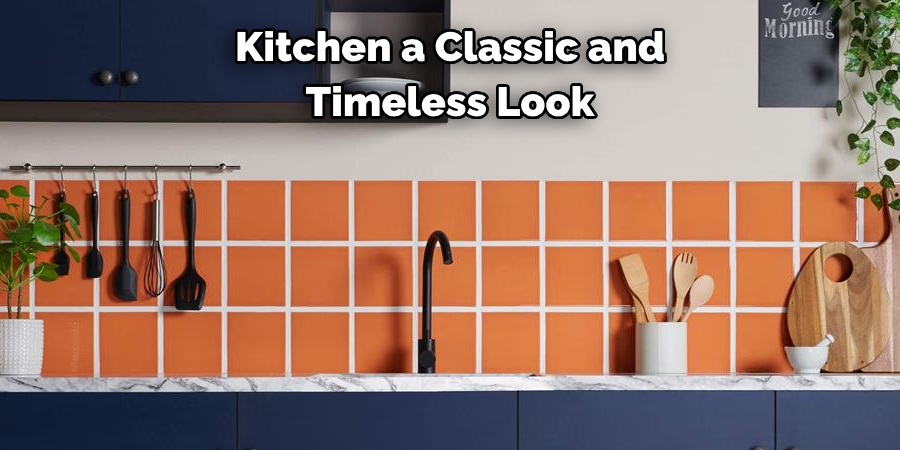
It is important, however, to regularly seal soapstone countertops to maintain their protective properties.
4. Adding a Stone Mosaic Tile Backsplash:
Stone mosaic tiles are a beautiful and unique way to protect your wall behind the kitchen sink. They are available in various colors and designs, making it easy to find one that fits your kitchen’s style. Stone mosaic tiles are also easy to clean and maintain, making them a great option for those who want an attractive and durable backsplash. So, if you’re looking for a backsplash that will make a statement, stone mosaic tiles are the way to go.
It’s important to properly seal the tiles to ensure they are protected from any potential water damage. Otherwise, the tiles may become discolored or damaged over time.
5. Use Garanite Panels:
Granite is a strong and durable natural stone that is perfect for use in the kitchen. It is resistant to heat, scratches, and stains. Granite is also very easy to clean and maintain. This makes it an ideal material for backsplashes. Granite panels are available in various colors and designs, making it easy to find one that fits your kitchen’s style.
The only downside to using granite panels is that they can be expensive. But if you have the budget for it, this is a great option for protecting your kitchen walls.
6. Creating a Faux Painting Technique:
Faux painting is a great way to add some pizzazz to your kitchen without spending much money. This backsplash idea involves painting your wall behind the kitchen sink to look like stone, Tile, or even wood. Faux painting is a great way to add interest to your kitchen without breaking the bank.
You can also use a waterproof sealant over the paint to provide an extra layer of protection for your walls.
7. Hanging Woven Tapestries:
Woven tapestries are a beautiful and unique way to protect your wall behind the kitchen sink. They add color and interest to your kitchen while protecting your wall from spills and splashes. Woven tapestries are available in various colors and patterns to match your kitchen décor. Tapestries can be hung using Command strips or tacks.
But it’s important to note that woven tapestries may not be as easy to clean and maintain compared to other backsplash options.
8. Use Shelf Liners:
Shelf liners are an easy and inexpensive way to protect your wall behind the kitchen sink. They come in various colors and patterns to match any décor and can be easily cut to fit your space. Be sure to clean the wall behind the sink before applying the liner, and then peel and stick it in place.
It’s important to regularly replace the shelf liner when it gets dirty or worn out to ensure continued protection for your walls.
9. Apply Sealant to Your Tiles and Grout.
Once your tiles are clean and dry, it’s time to apply a sealer. This will help protect your grout from staining and make it easier to clean in the future. You can find tile and grout sealers at most home improvement stores. If you want to be extra cautious, apply a waterproofing sealer to your tiles before applying the grout sealer.
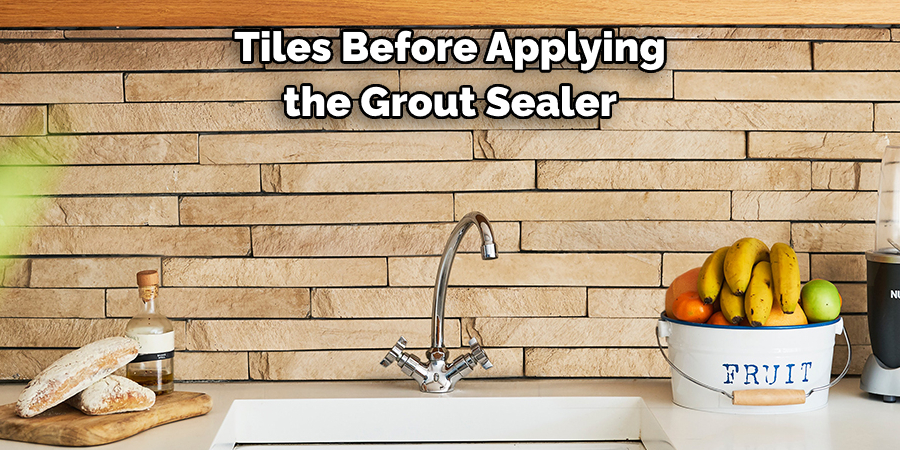
You may need to reapply the sealant every few years, depending on its longevity and how often your kitchen sink area gets wet.
10. Cover with Contact Paper:
Contact paper is a great way to protect your wall behind the kitchen sink and add a bit of color or style at the same time. It is available in various colors and patterns and can be easily cut to fit your space. Be sure to clean the wall behind the sink before applying the contact paper, and then peel and stick it into place. Then, if you want to remove it later, it will come off easily without damaging the wall.
It’s important to note that contact paper is not as durable as other options, so it may need to be replaced more frequently. But it’s a budget-friendly and easy option for protecting your kitchen walls.
Few Tips to Prevent Leaks in Kitchen Sink:
1. Use a kitchen sink liner or mat to protect the wall behind your kitchen sink from scratches and chips.
2. If you have a garbage disposal, use it properly and clean it regularly to prevent leaks.
3. Inspect your plumbing regularly for leaks and repair them promptly if you find any.
4. Be careful not to over-tighten the faucet and handles to avoid stripping the threads and causing leaks.
5. If you have a sprayer attachment on your kitchen sink, be sure to use it properly to avoid leaks.
With proper care, you can prevent leaks in the wall behind your kitchen sink and keep it looking new for years to come.
You Can Check It Out Seal Beadboard Backsplash
Frequently Asked Questions:
Q1: Can I Install a Backsplash Myself?
A: Yes, backsplashes are relatively easy to install and can be done by yourself with the right tools and materials. You can also hire a professional if you are not comfortable with DIY projects. It is important to follow the manufacturer’s instructions for proper installation. You can also find tutorials online for guidance.
Q2: How Do I Clean and Maintain My Backsplash?
A: The best way to clean your backsplash depends on the material it is made of. Generally, a gentle cleaner or warm water and soap will do the trick. Avoid using harsh chemicals or abrasive materials that can damage the surface. Regularly wiping down your backsplash with a damp cloth and drying it afterward can help maintain its appearance.
Q3: Can I Change My Backsplash if I Get Tired of it?
A: Yes, backsplashes can easily be changed or updated to give your kitchen a fresh new look. Some materials, like contact paper or tile stickers, can be removed without damaging the wall behind it. Other materials, like tile or stone, may require some effort to remove but can be replaced with a new backsplash. Consider choosing a removable backsplash if you like to frequently change up your kitchen’s décor.
Q4: How Do I Know If My Kitchen Sink Is Leaking?
A: Signs of a leaky kitchen sink include puddles of water under the sink, water stains on the wall behind the sink, and a musty smell. If you notice any of these signs, it’s important to inspect your plumbing for leaks or contact a plumber for assistance.
Final Thoughts
Kitchen sinks are one of the most frequently used areas in a home. The constant use and exposure to water can take its toll on the walls behind the sink, which is why it’s essential to protect them with a backsplash. There are many different materials you can use for your kitchen backsplash, but Tile is often a popular choice because it’s durable and easy to clean. When choosing Tile for your kitchen backsplash, there are several things you need to keep in mind.
First, ensure the tiles are rated for wet areas so they can withstand moisture. Second, choose a color or pattern that complements your cabinets and other decor. Finally, be sure to have the Tile installed by a professional so it’s done correctly and will last for many years. We hope this guide on how to protect wall behind kitchen sink has been helpful. If you have any questions or want to know more, feel free to comment below!
You Can Check it Out to Paint a Kitchen Sink
Professional Focus
Angela Ervin, a former interior designer turned blogger, specializes in kitchen design and renovations. Through her website, she blends her passion for cooking with design expertise, sharing practical and creative ideas. Known for balancing functionality and beauty, Angela’s insightful content has made her a trusted voice in home design and lifestyle.
About the Author
Angela Ervin, an experienced interior designer and blogger, combines her passion for kitchen renovations with storytelling. Living in Petersburg with her family, she enjoys cooking and testing her projects firsthand. Known for her humor and relatable style, Angela shares creative, functional design insights through her content, making her a trusted voice in home design.
Education History
University: Virginia Commonwealth University
Degree: Bachelor of Fine Arts (BFA) in Interior Design
- Angela’s education at VCU focused on mastering core interior design principles, including spatial planning, color theory, materials selection, and sustainable design practices.
- She gained hands-on experience through studio projects and collaborative design exercises, which honed her ability to create functional and aesthetically pleasing environments.
- Her coursework also emphasized problem-solving and practical applications of design, preparing her for real-world projects like her self-directed kitchen renovations.
- The program’s strong foundation in both technical skills and creative expression shaped Angela’s ability to seamlessly integrate form and function in her work.


